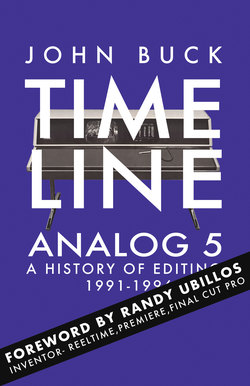Читать книгу Timeline Analog 5 - John Buck - Страница 16
На сайте Литреса книга снята с продажи.
QUICKTIME
ОглавлениеOn December 2, 1991 QuickTime shipped and Apple lined up forty developers to pledge support including SuperMac's Steve Blank who cheekily told the press:
Apple has advanced a digital-video standard on personal computers two years before anybody else expected it, and a day and a half ahead of Microsoft's next press release.
QuickTime 1.0 worked on any color-capable Mac with a 68020 processor. It offered built-in compression that created a 160 by 120 pixels movie running at 5 to 10 frames per second with an eight-bit mono audio track.
Craig Birkmaier looks back at QuickTime.
A lot of industry people just saw QuickTime as being the same as Windows Media Player; it was just a way to play back video. Nothing could be further from the truth; it was architecture for working with digital media.
How could anyone survive without it now? Back then it wasn't obvious, and Apple's management was struggling with how to make money from it.
Digital F/X’s Rob Gruttner recalls the launch.
I remember it launching and being on the cover of MacWeek magazine, “QuickTime ready for prime time” and making a big deal of it and I remember so many people saying, “ I don’t get it, big deal they’re postage sized movies that are difficult to see and low quality but there was another group I spoke to who really understood what this would lead to.
One group thought it was an Apple gimmick, a sideline amusement, and the others, who got it.
Digital Media’s Denise Caruso 'got it' telling MacWeek:
There are a lot of applications for non-full-motion video. You don't need to have Indiana Jones-style, full-motion video to film the inside of a house for a real-estate firm or to send snippets of video across electronic mail.
Jerry Borrell wrote for MacWorld
QuickTime is not just something that will allow nerds and video freaks to have MTV on their Mac. Nope. QuickTime is going to change how the world uses computers.
Steve Blank defined the opportunity for developers:
We see 2 million QuickTime-ready Macs out there without video-input capabilities. We think that once people start seeing QuickTime movies they're going to want to bring in their own video. All those people are potential customers.
Apple's VP of Macintosh Software Architecture Roger Heinen told the press:
We believe that QuickTime will spawn a whole new era in personal computing. In 1984, Apple introduced users to the combination of text, and graphics.
Today we are extending the combination to include video, sound and animation. QuickTime combined with exciting new third-party innovations will provide Macintosh users with powerful new functionality while maintaining the simplicity and consistency users have grown to expect.
Birkmaier concludes:
It wasn't until Jobs returned and realized it was a building block for products that QuickTime really took off.
